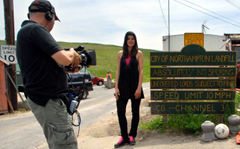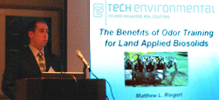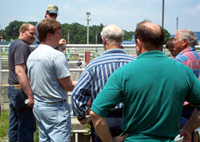Tech Environmental e-Newsletter
N-BUTANOL ODOR SCALE IN USE ACROSS THE NORTHEAST Tech Environmental has long advised regulators and communities to avoid setting an impossible target of "no odors" for industrial and municipal facilities. Since odor is quite literally everywhere, and encompasses everything from foul sludge fumes to the delicious scent of fresh baked goods, it is unreasonable to expect a community to be free of odors. Moreover, an odor nuisance must be determined in scientific and objective terms, and must take into account the broad spectrum of subjectivity in human odor perception. Since no scientific instrument exists that can match the power of the human nose, it is crucial to apply objective measures to odors that each individual percieves differently.
n-Butanol jars allow odor responders to objectively measure an odor's intensity in the field
Instead of seeking an unachievable standard of "no odors," regulators and communities should define in quantitative terms what defines a nuisance in a given area. One way to quantify odors is to use the n-butanol scale to determine the intensity of a particular odor. An odor responder can compare the intensity of an odor he percieves in the field to the odor in a set of control jars, each containing a less dilute concentration of butyl alcohol as the scale increases. In this way, an odor responder can establish an objective measure of an odor's intensity, while regulators can establish a nuisance guideline based on objective intensity levels. This method is now in use in many settings throughout the Northeast. Tech has worked directly with officials in NY, ME, MA and NH to implement this technique. While utilizing the n-butanol scale is not the be-all-end-all of responsible odor management, it is a significant first step towards sophisticated handling of odor impact concerns. Increasing use of quantitative tools, along with the implementation of odor training for both facility staff and regulatory officials, will greatly advance the quality of odor regulation and the ability of industrial and municipal facilities to control odors. This impact can be seen in a recent article from the Biddeford-Saco-Old Orchard Beach Courier regarding a dispute between the Maine Energy Recovery Company and the City of Biddeford, ME. While at first glance the conflict seems all too familiar - the City fined the facility for undue odorousness, while the facility disputes the validity of the fine - it is compelling to note that both sides in the dispute have accepted and implemented n-butanol quantification. In this case, a "3" or above is considered worthy of a fine by Biddeford regulators. Additionally, both the city and the facility are now utilizing odor training to ensure that odor responders on both sides are able to "differentiate between severities of odors."
Implementing proactive odor response and an Tech Environmental has provided odor evaluation services to the landfill in the Town of Northampton (MA), which has recently been the subject of a multitude of press reports for hiring a "sniff squad" of trained odor responders to monitor potential odor impacts. While the reports are often filled with inaccuracies - one blogger erroneously referred to the n-butanol system as "the world's smelliest scratch and sniff" - they all make note of the use of an objective scale to measure odors. Using this odor response mechanism, the landfill has been able to obtain an accurate measure of odor reports. This ability, coupled with other improvements in odor control at the landfill, has led to a dramatic drop in community odor complaints. Meanwhile, an upcoming Discovery Channel show may turn the local responders into odor-fighting celebrities. As the report from Biddeford, ME makes clear, objectively measuring intensity is only one piece of the puzzle, and not a panacea for all odor concerns. The specific violation cited by Biddeford is debatable, given that a single "3" could be an isolated incident lasting only a moment. For this reason, Tech has long supported the use of "FIDO" standards (frequency, intensity, duration, offensiveness) as a way to define all the aspects of odor nuisance potential. However, the widespread use of the n-butanol scale as an objective point of reference and the implementation of odor training represent commendable steps towards responsible odor management. The use of these procedures will likely lead to fewer odor events for everyone. Trained individuals can still differ on the ultimate ranking of particular odor events, but "no odors" is quickly becoming a thing of the past.
SUBSCRIBE TO THIS NEWSLETTER If you have been forwarded this email and wish to receive it regularly, click here to subscribe. |
TECH STAFF SPOTLIGHT
Matthew Riegert presented a paper on odor training at the
2008 NEWEA Annual
Mr. Riegert is an environmental engineer with diverse experience in air sampling, compliance permitting, and acoustic monitoring and modeling. He has provided expertise on numerous Tech Environmental projects, performing tasks such as air quality, odor and noise sampling, acoustic and air quality dispersion modeling, preparation of various permit applications, and design of odor control systems. You can contact Matthew Riegert by email at mriegert@techenv.com or by telephone at ODOR TRAINING FOR FACILITIES AND REGULATORS Tech Environmental has presented its Odor Training seminars to many organizations, including the Maine Department of Environmental Protection, Massachusetts Landfill Operators, the New Hampshire Water Pollution Association, local Boards of Health, industrial clients, and groups of concerned citizens. Our introductory seminar, "Fundamentals of Odor", has been accredited by the Solid Waste Association of North America (SWANA), the New England Interstate Water Pollution Control Commission (NEIWPCC), and by state Departments of Environmental Protection.This accreditation allows participants in Tech seminars to earn continuing education credits and certifications. The Fundamentals course includes modules that explain the basics of odor and odor science, an overview of typical odor potentials and identifiers, and a discussion of the various chemical, biological and thermal treatments available. The "Management of Odors" course uses odor sampling to tailor its content to each audience. For example, operators at a treatment plant would work with sample odors from their site in order to learn how to identify and mitigate specific odors from their facility. This seminar helps trainees deal with odors directly, and improves odor management at facilities with trained staff. To learn more about Tech's odor training services, contact Mike Lannan by email at mlannan@techenv.com.
CONTACT US 1601 Trapelo Road Waltham, Massachusetts 02451 ph. 781-890-2220 fax 781-890-9451
We are located at Reservoir Place on Trapelo Road off Exit 28, Rt. 128/I-95 in Waltham, Massachusetts.
|
| TECH ENVIRONMENTAL, INC. specializes in finding real solutions to air quality, odor control, noise and vibration, fugitive dust, and health & safety challenges. Our focused knowledge in air-quality-related fields is enhanced by a comprehensive understanding of environmental regulations and technologies. Visit our website at www.techenv.com or contact us by phone at (781) 890-2220. |



 Matthew L. Riegert, one of Tech's primary odor trainers, has far-reaching experience working with odorants and the sources that emit them. He has trained hundreds of people in the fundamentals of odor generation and odor chemistry, odor complaint response, and odor control basics. Mr. Riegert often screens facility employees, community responders, and others for odor sensitivity. He has also made several conference presentations on the topics of odor control and odor training, including recent speeches at the
Matthew L. Riegert, one of Tech's primary odor trainers, has far-reaching experience working with odorants and the sources that emit them. He has trained hundreds of people in the fundamentals of odor generation and odor chemistry, odor complaint response, and odor control basics. Mr. Riegert often screens facility employees, community responders, and others for odor sensitivity. He has also made several conference presentations on the topics of odor control and odor training, including recent speeches at the 

